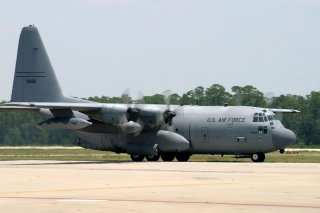The Air Force is Tansforming Cargo Planes Into Bombers With Palletized Weapons
How does that work?
The United States Air Force has been experimenting with turning its cargo and transport planes into munitions trucks that could drop bundles of weaponry. This would refine the concept for an “arsenal plane” that could haul huge numbers of munitions into combat, and have the cargo planes work alongside bombers.
Through a partnership with the Air Force Research Laboratory, the Air Force Special Operations Command (AFSOC) successfully released simulated “palletized” munitions from a MC-130J, a multi-mission, combat transport and special operations tanker. The three airdrops were made at Dugway Proving Ground, Utah this past January.
The Phase I operational demonstration munitions were stacked upon wood pallets—Combat Expendable Platforms (CEPs)—which were deployed via a roller system. AFSCO used the MC-130J Commando II since its cargo area supported the release of multiple, relatively large munitions using tried and proven procedures. The drops included five CEPs with six simulated munitions.
These included four Cargo Launch Expendable Air Vehicles with Extended Range (CLEAVERs). These long-range, high precision weapons can destroy enemy targets.
“In the end, the demonstration accomplished all objectives,” said Jerry Provenza, the AFRL CLEAVER program manager. In the three airdrops, all five CEPs separated cleanly from the aircraft, and the munitions separated from the CEPs.
“This successful [demo] is evidence of our commitment to evolve innovative weapons concepts and enhance our partnership with AFSOC to meet the needs of the National Defense Strategy,” added Col. Garry Haase, the director of AFRL’s Munitions Directorate. “CLEAVER represents a different approach to launching large numbers of long-range weapons, which will bring a new dynamic to the high-end fight.”
In future demonstrations, AFSOC will release CLEAVER glider vehicles, powered vehicles, and full-up vehicles with optional warhead and terminal guidance.
The employment of these weapons directly advances the Air Force palletized munitions experimentation effort, an innovative concept in which a multi-engine platform carrying large quantities of network-enabled, semi-autonomous weapons accompanies remotely piloted aircraft and fighter jets in combat missions.
One advantage for making such a transformation is that the Air Force has quite a number of cargo planes available, and it operates some 600 C-130 Hercules, C-17 Globemaster and C-5 Galaxy cargo planes. The C-130 has been doing its job of hauling men and material around the world for nearly 80 years but likely will remain in service for at least the next decade or longer.
This isn’t the first time that the Air Force has sought to convert a cargo plane into an armed aircraft. During the Vietnam War C-47 and C-130 transports were transformed into gunships, armed with multiple 7.62 mm miniguns that could selectively fire either 50 or 100 rounds per second. The former transport planes were prized for their endurance as these were designed to stay aloft for long periods, while their size allowed them to carry substantial weapon and ordnance loads.
Peter Suciu is a Michigan-based writer who has contributed to more than four dozen magazines, newspapers and websites. He is the author of several books on military headgear including A Gallery of Military Headdress, which is available on Amazon.com.
Image: Wikimedia

